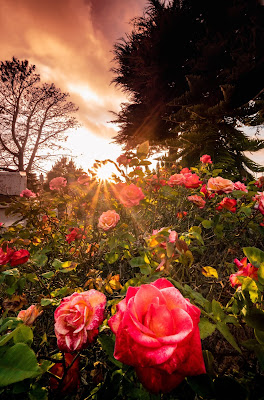 |
| Alfalfa flower |
 Blood Meal: This fertilizer is a by-product of meat packing and is usually sourced from cow blood. It is very high in nitrogen, which encourages leaf growth. It can also raise the acid level and lower the pH in soil. This meal is particularly effective when used for nitrogen-loving plants such as corn, broccoli, spinach, and other leafy greens. A side benefit of Blood Meal is that has some repellent properties when dry; deer and rabbits don’t like it. This article has some informative do’s and don’ts when using Blood Meal.
Blood Meal: This fertilizer is a by-product of meat packing and is usually sourced from cow blood. It is very high in nitrogen, which encourages leaf growth. It can also raise the acid level and lower the pH in soil. This meal is particularly effective when used for nitrogen-loving plants such as corn, broccoli, spinach, and other leafy greens. A side benefit of Blood Meal is that has some repellent properties when dry; deer and rabbits don’t like it. This article has some informative do’s and don’ts when using Blood Meal. Bone Meal: This is another by-product of the meat industry and, like Blood Meal, it generally comes from cows. Bones are dense in calcium and phosphorous to keep vertebrates strong and healthy. Plants need these same minerals to grow vigorous and robust cells and roots and to photosynthesis efficiently. Use Bone Meal early in the growing cycle to get those plants going. It is particularly good to use when planting bulbs, flowering annuals, perennials and ornamentals. Bone Meal can be dangerous to dogs if they consume it, this article has more on that and other guidelines for usage.
Bone Meal: This is another by-product of the meat industry and, like Blood Meal, it generally comes from cows. Bones are dense in calcium and phosphorous to keep vertebrates strong and healthy. Plants need these same minerals to grow vigorous and robust cells and roots and to photosynthesis efficiently. Use Bone Meal early in the growing cycle to get those plants going. It is particularly good to use when planting bulbs, flowering annuals, perennials and ornamentals. Bone Meal can be dangerous to dogs if they consume it, this article has more on that and other guidelines for usage.Crab Meal: Also sourced from a food industry, Crab Meal (and other shellfish fertilizers) is made from the left-over shells after the meat has been removed. These Crustacean shells are high in nitrogen, but also contain plenty of calcium, phosphorous and magnesium. While all of these ingredients are excellent for your plants, it is the chitin in Crab Meal that sets it apart. Chitin increases plants' cell wall strength and encourages populations of beneficial soil microorganisms. These microorganisms release enzymes that help control pest nematodes in the soil. Slugs and snails don’t like it either. Crab Meal can be applied anywhere in the garden, but is especially helpful in vegetable gardens/flower beds and when used as a compost amendment to stimulate decomposition and nutrient availability. Here is a short, but helpful, article on shellfish fertilizers.
Fish Bone Meal: This fertilizer, a byproduct of the fishing industry, is a comfortable alternative for many people made uncomfortable by the slaughterhouse source of traditional mammal bone meals. Fish Bone Meal is high in phosphorous and calcium and will give you plants that can absorb water and nutrients more easily. Great for all plants, but particularly for flowering plants, bulbs and new garden beds. You will see the results in bigger, brighter blooms and more vibrant vegetables. Here is a video on the subject.
 |
| Neem tree |
 Corn Gluten Meal: This is another fertilizer with a secret weapon – more on that in a minute. As a fertilizer, Corn Gluten Meal offers a non-burning, slow-release dose of nitrogen that will get the green going in your plants. This is especially true of turf, grasses, shrubs, trees and vegetable greens. This fertilizer should only be used on established lawns and plants (those that are rooted with true leaves), but use it as soon as the plants are ready in the spring to give them a strong start. And now to the secret weapon: When used in higher amounts than the fertilizer rate, Corn Gluten (in both granular and liquid forms) is an excellent pre-emergent to combat weeds. If you use it for this purpose, be careful to not apply in anywhere that you have just planted seeds or transplants.We carry a variety of Corn Gluten products. For more on this seemingly magical growth promoter and inhibitor in one, check out our blog on the subject.
Corn Gluten Meal: This is another fertilizer with a secret weapon – more on that in a minute. As a fertilizer, Corn Gluten Meal offers a non-burning, slow-release dose of nitrogen that will get the green going in your plants. This is especially true of turf, grasses, shrubs, trees and vegetable greens. This fertilizer should only be used on established lawns and plants (those that are rooted with true leaves), but use it as soon as the plants are ready in the spring to give them a strong start. And now to the secret weapon: When used in higher amounts than the fertilizer rate, Corn Gluten (in both granular and liquid forms) is an excellent pre-emergent to combat weeds. If you use it for this purpose, be careful to not apply in anywhere that you have just planted seeds or transplants.We carry a variety of Corn Gluten products. For more on this seemingly magical growth promoter and inhibitor in one, check out our blog on the subject.Here’s to happy planting!
Submitted by Pam























